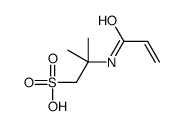

聚(2-丙烯酰胺-2-甲基-1-丙磺酸)结构式

|
常用名 | 聚(2-丙烯酰胺-2-甲基-1-丙磺酸) | 英文名 | poly(2-acrylamido-2-methyl-1-propanesulfonic acid) |
|---|---|---|---|---|
| CAS号 | 27119-07-9 | 分子量 | 207.24700 | |
| 密度 | 1.266g/cm3 | 沸点 | N/A | |
| 分子式 | C7H13NO4S | 熔点 | N/A | |
| MSDS | 中文版 | 闪点 | N/A | |
| 符号 |

GHS05 |
信号词 | Danger |
|
PAA-PAMPS copolymers as an efficient tool to control CaCO3 scale formation.
Langmuir 29(9) , 3080-8, (2013) Scale formation, the deposition of certain minerals such as CaCO3, MgCO3, and CaSO4·2H2O in industrial facilities and household devices, leads to reduced efficiency or severe damage. Therefore, incrustation is a major problem in everyday life. In recent years... |
|
|
Dielectric properties of micellar aggregates due to the self-assembly of thermoresponsive diblock copolymers.
J. Phys. Chem. B 115(10) , 2196-204, (2011) The radiowave dielectric properties of aqueous solutions of thermosensitive copolymers, consisting of poly(2-acrylamido-2-methylpropanesulfonate) [PAMPS] and poly(N-isopropylacrylamide) [PNIPAAM] with different block lengths, have been investigated over a bro... |
|
|
Anti-angiogenic activity of heparin-like polysulfonated polymeric drugs in 3D human cell culture.
Biomaterials 31(31) , 7863-72, (2010) The activity of new anti-angiogenic polymeric drugs was tested in a 3D endothelial cell culture system applied as a model of angiogenesis. The assay was performed in a highly reproducible fibrin matrix that supported endothelial cell attachment, proliferation... |
|
|
Hyaluronic acid affects the in vitro induction effects of synthetic PAMPS and PDMAAm hydrogels on chondrogenic differentiation of ATDC5 cells, depending on the level of concentration.
BMC Musculoskelet. Disord. 14 , 56, (2013) It has been a common belief that articular cartilage tissue cannot regenerate in vivo. Recently, however, we have found that spontaneous hyaline cartilage regeneration can be induced in vivo by implanting a synthetic double-network (DN) hydrogel, which is com... |
|
|
Surface sliding friction of negatively charged polyelectrolyte gels.
Colloids Surf. B Biointerfaces 56(1-2) , 296-302, (2007) The friction between two polyelectrolyte gels carrying the same or opposite sign of charges has been investigated using a rheometer. It is found that the friction was strongly dependent on the interfacial interaction between two gel surfaces. In the repulsive... |
|
|
Influence of polyelectrolyte on the thermosensitive property of PNIPAAm-based copolymer hydrogels.
J. Mater. Sci. Mater. Med. 18(9) , 1771-9, (2007) A new family of poly(NIPAAm-co-2-acrylamido-2-methyl-1-propanesulfonic acid) [P(NIPAAm-co-AMPSA)] hydrogels was synthesized by incorporating negative charged AMPSA to the backbone of the PNIPAAm-based hydrogel. The effect of polyelectrolyte (i.e., PAMPSA) on ... |
|
|
Selective cell spreading, proliferation, and orientation on micropatterned gel surfaces.
J. Nanosci. Nanotechnol. 7(3) , 773-9, (2007) Hydrogel micropatterns of 10 approximately 200 microm in width were introduced during the polymerization of 2-acrylamido-2-methyl-propane sulfonic acid sodium salt (NaAMPS) on the surface of polyacrylamide (PAAm) gel. Behaviors of endothelial cells on the mic... |
|
|
Gene expression profile of the cartilage tissue spontaneously regenerated in vivo by using a novel double-network gel: comparisons with the normal articular cartilage.
BMC Musculoskelet. Disord. 12 , 213, (2011) We have recently found a phenomenon that spontaneous regeneration of a hyaline cartilage-like tissue can be induced in a large osteochondral defect by implanting a double-network (DN) hydrogel plug, which was composed of poly-(2-Acrylamido-2-methylpropanesulf... |
|
|
Novel polymer blends for the preparation of membranes for biohybrid liver systems.
J. Biomater. Sci. Polym. Ed. 20(5-6) , 821-39, (2009) It was found previously that membranes based on co-polymers of acrylonitrile (AN) and 2-acrylamido-2-methyl-propansulfonic acid (AMPS) greatly stimulated the functionality and survival of primary hepatocytes. In those studies, however, the pure AN-AMPS co-pol... |
|
|
Analyzing polyaniline-poly(2-acrylamido-2-methylpropane sulfonic acid) biocompatibility with 3T3 fibroblasts.
J. Biomater. Sci. Polym. Ed. 21(5) , 623-34, (2010) Conductive polymers can be utilized as unique functional elements in future intelligent biomaterials required for tissue engineering, cell stimulation and drug delivery. Research in these areas could be limited by established methods of conductive polymer syn... |